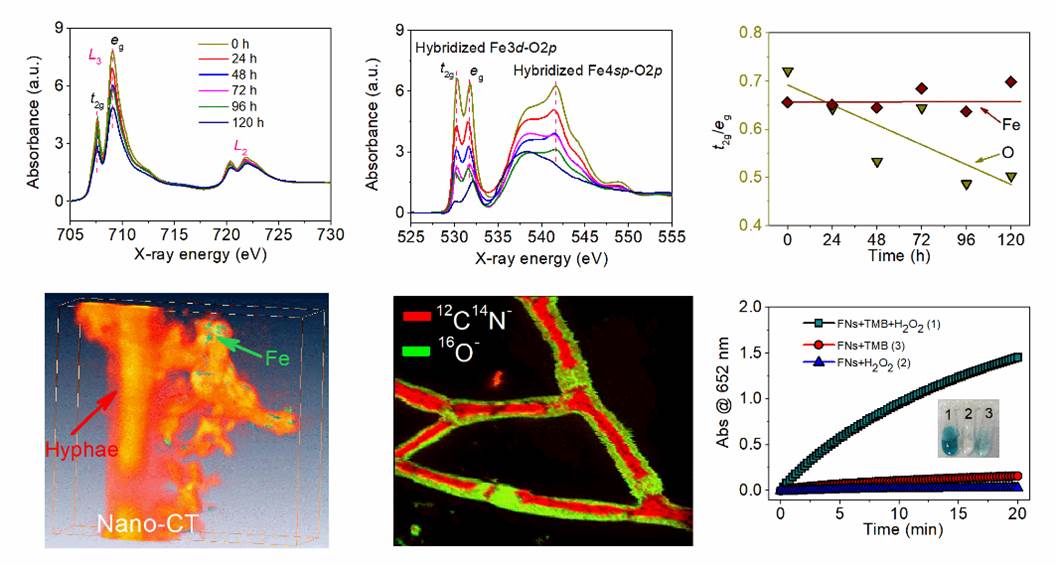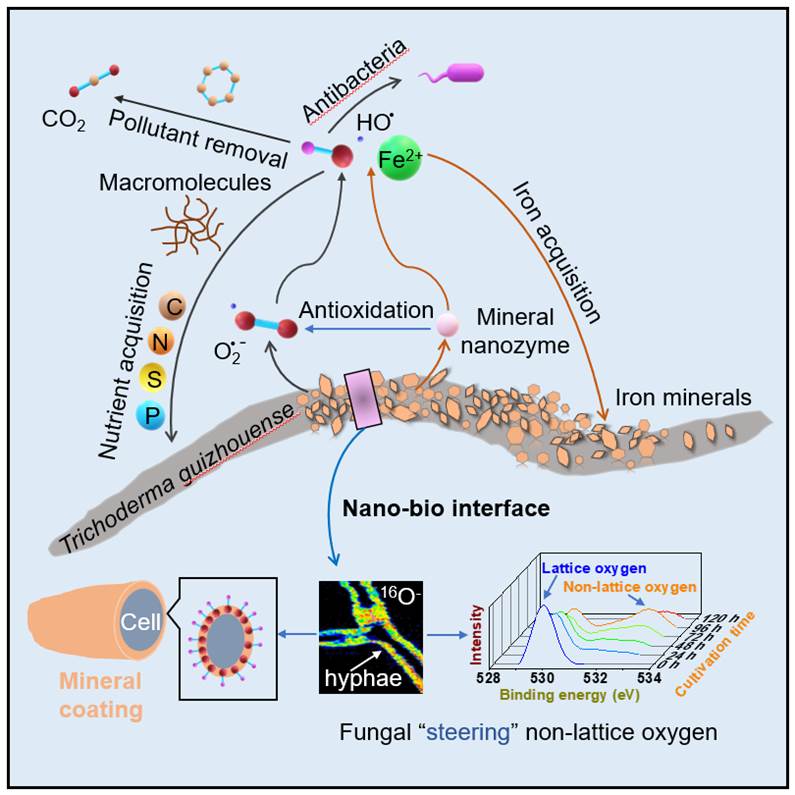Microbe-mineral interactions have shaped the surface of the Earth and impacted the evolution of plants and animals. Although more than two-thirds of known mineral species have biological imprints, how the biotransformation of minerals may have benefited microbial development, beyond nutritional and energetic use, remains enigmatic. In a new paper published in the journal Current Biology, Prof. Guanghui Yu and Prof. Henry H. Teng from School of Earth System Science in Tianjin University and the collaborators from Nanjing Agricultural University, University of Tubingen, and University of Dundee, have demonstrated that fungal nanophase particles could catalyze iron transformation for oxidative stress removal and iron acquisition.
In this research, Prof. Yu et al. have shown that biogenic ferrihydrite nanoparticles are extensively formed at the interface between an actively growing fungus and an iron-containing mineral, hematite. These biogenic nanoparticles formed through the fungus-hematite interactions can behave as mimetic catalysts, similar to nanozymes that imitate peroxidase which scavenges hydrogen peroxide for the mitigation of potential cytotoxicity. Evidence from various X-ray spectroscopic analyses, including soft X-ray absorption spectroscopy (XAS) and X-ray photoelectron spectroscopy (XPS), indicated that non-lattice oxygen in the nanomaterials was chiefly responsible for this catalytic activity, rather than through the conventional mechanisms of iron redox chemistry. Cryo-scanning electron microscopy, high-resolution (~30 nm) Nano-CT, and biomass analyses further confirmed that the organism was active and capable of mediating the catalytic reactions. Prof. Yu et al. therefore hypothesize that this confers an advantage to the organism in terms of protection from oxidative stress and ensuring the acquisition of essential iron.
Given the teragram (Tg)-level abundance of mineral nanoparticles in the Earth system, it is statistically highly probable for some of them, particularly those of biotic origin, to behave similarly to the ferrihydrite nanoparticles as mimetic catalysts. Regardless of the origin of the nanoparticles, over 100 types of natural and engineered nanomaterials have been reported to possess intrinsic enzyme-like catalytic activities. As such, a previously unknown feedback route of microbe-mineral coevolution may have revealed itself in the form of mineral nanozymes that could shed light on long standing issues such as the origin and evolution of life by modulating reactive oxygen species (ROS) levels. Because more than two-thirds of mineral species in the Earth’s surface have biological imprints, this current study raises new questions about the roles of biogenic nanomaterials in the coevolution of the lithosphere and biosphere, and provides a step towards understanding the feedback pathways controlling the evolution of biogenic mineral formation.
Recently, this work has been published by Current Biology (2020, 30: 2943–2950). This work was supported by the National Natural Science Foundation of China (Grant Nos. 41977271, 41830859, and 41972041). The authors thank Drs. Xiangzhi Zhang and Lijuan Zhang and Nian Zhang for help and support at beamlines BL08U1-A and BL02B02 at Shanghai Synchrotron Radiation Facility, Wanxia Huang and Qingxi Yuan at 4W1A beamline at Beijing Synchrotron Radiation Facility, and Jiani Chen at State Key Laboratory for Mineral Deposits Research, School of Earth Sciences and Engineering, Nanjing University.
Article information
Guang-Hui Yu*, Zhi-Lai Chi, Andreas Kappler, Fu-Sheng Sun, Cong-Qiang Liu, Hui Henry Teng*, Geoffrey Michael Gadd*. Fungal nanophase particles catalyze iron transformations for oxidative stress removal and iron acquisition. Current Biology, 2020, 30(15): 2943–2950.
Website: https://doi.org/10.1016/j.cub.2020.05.058

Figure 1. Fungal “mineral coating” and its nanozyme activity.

Figure 2. Schematic diagram of fungal produced mineral nanozyme and its impact on oxidative stress removal and iron acquisition.